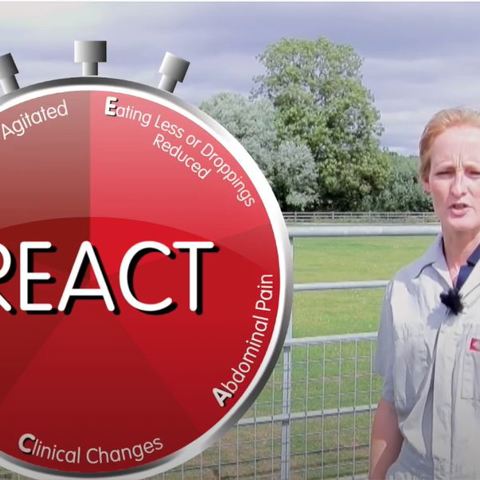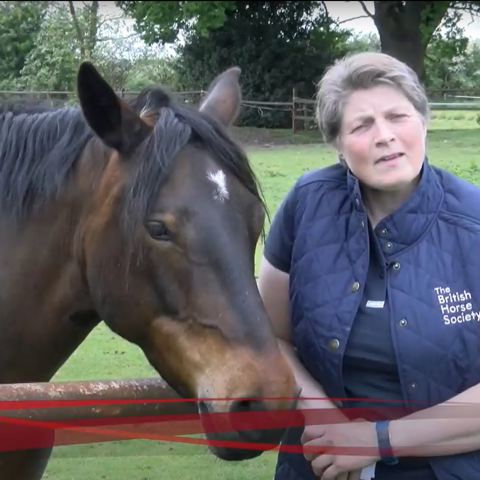In conjunction with

Equine colic is the most common emergency and cause of death in horses worldwide 1. There are different types of colic which can only be assessed and confirmed by a vet. The severity, causes and treatment plans for the different types of colic vary but all will result in abdominal pain. Horses will respond differently to their pain, with some becoming dangerous to handle, while others remain stoic and show only subtle signs that something is wrong. Always keep yourself and others safe.
Advice specific to donkeys is available from The Donkey Sanctuary.
Types of colic
Spasmodic colic
chevron-down
chevron-up
- One of the most common types of colic
- Intermittent sharp bouts of pains, presumed to be when sections of the gut contracts in an abnormal manner
- Loud gut sounds may be heard
Tympanic colic (flatulent/gas colic)
chevron-down
chevron-up
- Excess gas builds up in the intestines, causing them to over stretch and become painful
- High pitch gut sounds and horses can look bloated.
Impaction colic
chevron-down
chevron-up
- A blockage obstructs the digestive system and prevents normal passage of food through the gut
- Low grade prolonged pain often with more subtle signs.
Sand colic
chevron-down
chevron-up
- Accumulation of sand and dirt in the digestive tract which can irritate the bowel lining
- Sand may be present in the horse’s droppings.
Displacement colic
chevron-down
chevron-up
- A section of the gut moves abnormally within the abdomen which can cause an obstruction.
Strangulation colic
chevron-down
chevron-up
- A portion of gut becomes strangled, which results in the blood supply being cut off to the affected area
- Incredibly serious form of colic that will likely require surgery or euthanasia.
Signs and symptoms
Colic cases in horses and ponies can deteriorate quickly, so early recognition and prompt veterinary attention is vital to increase your horse’s chance of recovery or in critical cases to prevent any unnecessary suffering.
If you notice any signs of distress or changes in a horse’s behaviour, think REACT and immediately contact your vet for support.
Restless or agitated
chevron-down
chevron-up
- Attempts to lie down
- Repeatedly rolling
- Unexplained sweating
- Box-walking or circling.
Eating less or droppings reduced
chevron-down
chevron-up
- Eating less or nothing at all
- Passing fewer or no droppings
- Changes in consistency of droppings.
Abdominal pain
chevron-down
chevron-up
- Flank watching
- Pawing
- Kicking at belly.
Clinical changes
chevron-down
chevron-up
- Increased heart rate
- Reduced or absent gut sounds
- Changes in colour of gums (healthy gums should be a salmon pink colour)
- Rapid breathing rate
- Skin abrasions over the eyes (indicates that the horse has been thrashing around and has caught this prominent area on their face, for example on the walls of the stable).
Tired or lethargic
chevron-down
chevron-up
- Lying down more than usual
- Lowered head position
- Dull and depressed.
Contact your vet
- If you notice any of the REACT signs call your vet immediately
- Share a What3Words location or a map pin drop with them
- For difficult locations, if safe to do so, get someone to stand by the roadside to help direct them.
Waiting for the vet to arrive?
Horses in pain may display uncharacteristic behaviours and may not be aware of their surroundings. Make sure you take necessary measures to safeguard your, and your horse’s, safety at all times. The below are recommendations, always the assess the situation and if it’s not safe do not proceed:
- Keep your horse on a lunge line in a safe area of a field or arena and wear a hat and gloves for safety.
- Alternatively, you can put your horse in a stable or shelter and make sure any buckets or objects they could injure themselves on are removed. Wait for veterinary support to re-enter the stable of a distressed horse.
- Allow the horse to lie down or roll if they wish to, it won’t make colic worse.
- Gentle walking may be comfortable for the horse, however, do not force a horse to move if they’re reluctant.
- While waiting, check your emergency care plan which will help when making decisions.
Vet assessment and treatment
The vet will examine your horse and may perform a rectal examination or nasogastric intubation to assess different parts of the digestive tract. Vets can offer treatment for colic with various medications at the yard to relieve pain and address the colic. Referral to an equine hospital may be advised depending on the type and severity. This could be for further evaluation, continuous observation, medical treatment or potential surgery.
Emergency decision making
Colic can often be time-critical, especially if referral to hospital is required. We strongly recommend an emergency care plan is created in advance to assist with making an informed decision in time-sensitive and potentially emotional situations.

Preventing colic in horses
Any horse can be affected by colic; however, the risk can increase with age, following recent changes in diet or management and in horses who’ve previously suffered with colic, particularly those who’ve had colic surgery.

References
chevron-down
chevron-up
1. Bowden, A., et al. (2017). Prevalence and outcome of conditions seen at out‐of‐hours primary assessment at two practices over a 3‐year period (2011–2013). Equine Vet. J, 49.
2. Bowden, A., et al. (2020). Horse owners’ knowledge, and opinions on recognising colic in the horse. Equine veterinary journal, 52(2), 262-267.
3. Bowden, A., et al. (2020). Indicators of ‘critical’ outcomes in 941 horses seen ‘out‐of‐hours’ for colic. Veterinary Record, 187(12), 492-492.
Get in touch – we’re here to help
The Horse Care and Welfare Team are here to help and can offer you further advice with any questions you may have. Contact us on 02476 840517* or email welfare@bhs.org.uk – You can also get in touch with us via our social media channels.
Opening times are 8:35am - 5pm from Monday – Thursday and 8:35am - 3pm on Friday.
*Calls may be recorded for monitoring purposes.




